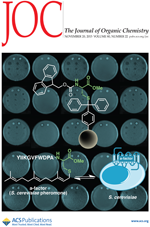

Main navigation | Main content
11/20/2015
Recent research from the research group of Professor
As featured on the November 20, 2015, cover of the Journal of Organic Chemistry, graduate student Veronica Diaz-Rodriguez in Professor Mark Distefano’s group is the lead author on a paper describing new methodology for the synthesis of peptides containing C-terminal cysteine esters.
Such functionality is found in a wide range of natural products such as yeast mating pheromones and also as a substructure present at the C-termini of Ras proteins, key enzymes involved in many diseases including cancer.
Inspired by side-chain anchoring strategies pioneered by Professor George Barany and co-workers, Diaz-Rodriguez et al. developed a method for preparing peptides with a variety of C-terminal ester groups including methyl, ethyl, isopropyl and benzyl esters. This was accomplished by synthesizing Fmoc-protected cysteine derivatives bearing various ester functionality and immobilizing the compounds to a trityl-based resin via the cysteine side chain; standard solid phase synthetic methods were then used to elongate them. Detailed HPLC and NMR studies demonstrated that this strategy led to successful synthesis of these peptides with minimal epimerization at the cysteine residue. Using this approach, a-factor, a yeast mating pheromone was prepared.
While the smaller methyl, ethyl and isopropyl esters were found to manifest full activity in yeast mating assays (performed in collaboration with Elena Ganusova and Jeffrey M. Becker at the University of Tennessee), the benzyl ester-containing analogue was found to be approximately 100-fold less active. These results suggest that there is a defined binding pocket within the receptor that interacts with the C-terminal region of a-factor.
Currently, graduate students Jeffrey Vervacke and Elyse Krautkramer are using this approach to prepare peptides substrates bearing C-terminal esters that are processed by Ste24, a protease involved in premature aging diseases.
The full article is available on the Journal of Organic Chemistry website.
